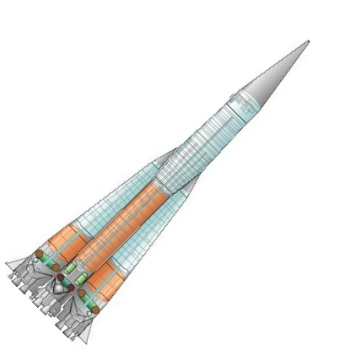 Sometimes there is just one good way of doing things. Look at the average car these days. 4 wheels, driver at the front to one side, engine usually at the front, usually rear wheel drive... not a lot different in its basics than a model T Ford.
Sometimes there is just one good way of doing things. Look at the average car these days. 4 wheels, driver at the front to one side, engine usually at the front, usually rear wheel drive... not a lot different in its basics than a model T Ford.The Drawing at the right, courtesy of Mark Wade's superb Encyclopedia Astronautica is that of a Russian R-7 booster, in its military form known as the SS-6 SAPWOOD. From The Space Review :
As a far as long-lived boosters go, they are the rule in the launch business. Even limiting our examination to only 21st century launches, we find that the most-launched vehicle since we turned the corner on the new millennium is the Russian Soyuz/Molniya series, with over 60 launches since January 1, 2001. These vehicles are, frankly, rather uninspired evolutionary developments of the SS-6 Sapwood, the world’s first ICBM, and also the vehicle that launched both the first artificial satellite, Sputnik, as well as the first manned space mission.
As a far as long-lived boosters go, they are the rule in the launch business.
The SS-6 was, in many respects, a straight-line development of the World War 2 German V-2 ballistic missile. Today’s Soyuz booster engines still use hydrogen peroxide to drive the turbopumps, just like the V-2, and employ multiple thrust chambers, each of which is very close to the size used in the V-2. Even the thrust chamber injectors for the old Soviet and older German vehicles are close to being identical in design. The Soyuz is not just a bunch of V-2’s strapped together, but it doesn’t miss that concept by too much.
Okay, so the Soyuz is ancient; in fact, in space age terms, it is literally prehistoric.
Meanwhile, the USA is, for the very first time, developing an Expendable Launch vehicle that wasn't originally designed for lobbing thermonuclear warheads about the joint. In fact, it's developing two of them.
The less than wonderful outcome is described by Wayne Eleazer, responsible for initial planning of the EELV (Evolutionary Expendable Launch Vehicle) concept. I'll just give two quotes from his article, which is worth reading in its entirety.
The Air Force took a guess at enveloping the commercial requirements. Such a move was wise, and both noble and necessary—and they blew it.
They can't really be blamed given the circumstances, but yes, unfortunate.
NASA finally bought EELV boosters, coincidentally or not only after abandoning the new RLV that had been started at the same time as the Air Force program. But NASA’s lack of input to the EELV requirements process had its impact. Both the Delta and Atlas were designed to save money by flying lofted trajectories not particularly well-suited to carrying winged Shuttle replacements in particular or manned payloads in general. At best, it will take some work to make them capable of carrying manned vehicles; at worst it will take a clean sheet of paper.
Based on fifty-plus years of history, we can conclude that Delta 4 and Atlas 5 will indeed be around for a long time. That in itself is neither bad nor unexpected. At least we are no longer utterly dependant on first-generation ICBM technology. But perhaps we should consider the new vehicles’ true ancestry.
Delta 4 is built around an engine derived from the Space Shuttle, a vehicle that proved to be so complex and costly that no one is even considering building anything like it ever again. Atlas 5 is designed around a engine developed to launch the Soviet copy of the Shuttle, a vehicle that would never haven been developed had the US not built the Shuttle, and which almost immediately was recognized as being something less than useless. The Soviet shuttle, Buran, flew but once, unmanned. At least the surviving US shuttles are flying.
So, Delta 4 and Atlas 5 arrived decades later than they should have, are less capable than they should be, cost more than they ought to, and are based not on new cutting-edge technology designed to conquer the universe but on old hardware developed for a failed concept and its foreign copy. And they are still, by far, the best we have—and that in its own way is rather sad
These boosters are not man-rated. They ar not even particularly suitable for being modified so that they can safely carry crews "to infinity and beyond" - or even low Earth Orbit.
They are the best the US has though, once the Shuttles are retired. In what, 4 years time?
We need to do better. Or start learning Mandarin.

2 comments:
More informations about the Buran Space Shuttle:
http://www.buran-energia.com
A lot of folks think the Chinese are heirs to the stars, but I'm not so sure. Private enterprise is still in infancy and has been very impressive so far. If you're looking for the next nation to really make an impact in space, look to India.
Ted
Post a Comment